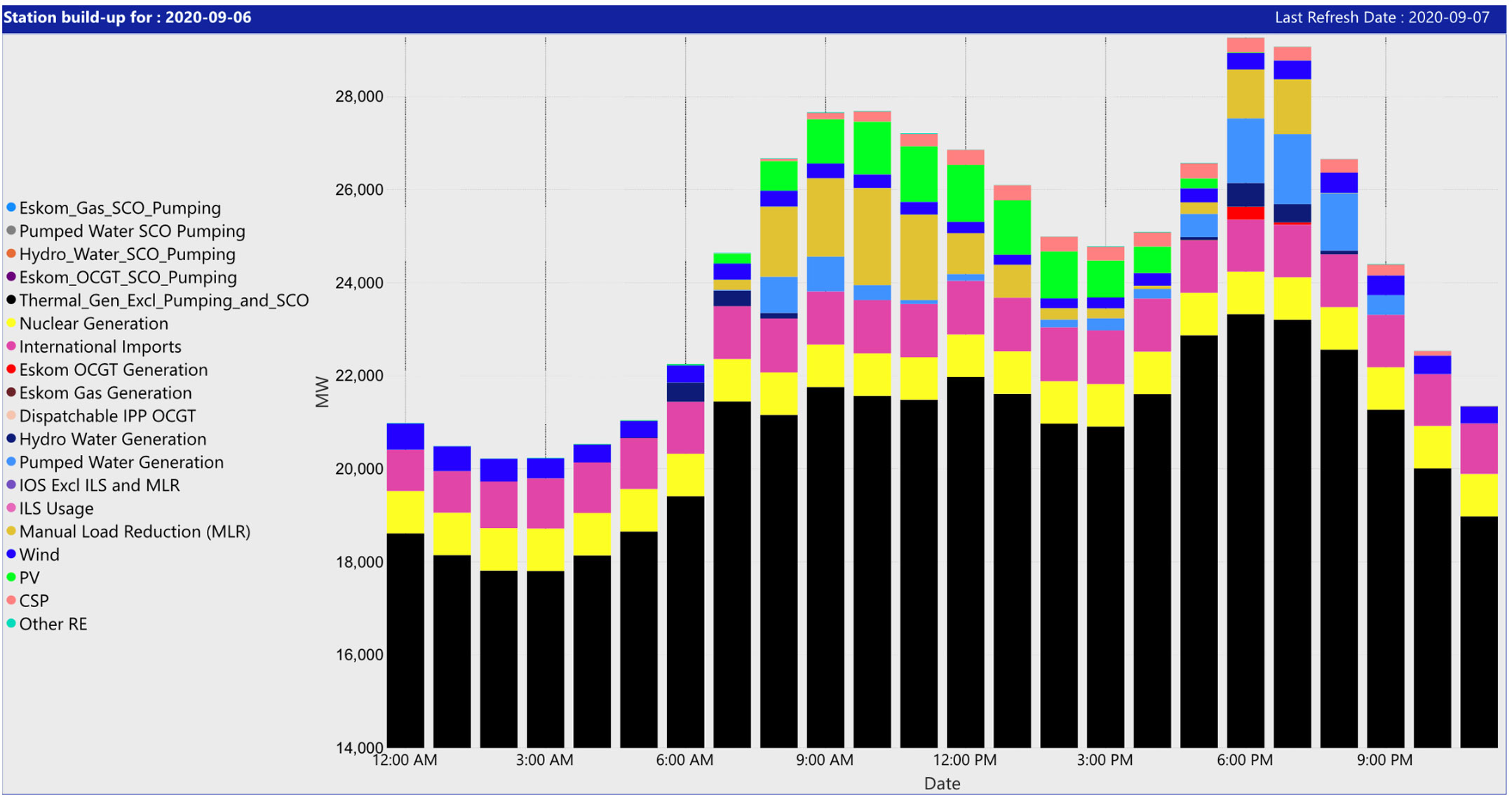 Eskom has taken Unit One of Koeberg offline earlier than planned for scheduled maintenance after “an increasing leak rate was observed on one of three steam generators”.
Eskom has taken Unit One of Koeberg offline earlier than planned for scheduled maintenance after “an increasing leak rate was observed on one of three steam generators”.
The unit had been scheduled to be taken offline for refuelling and routine maintenance starting in February. Eskom says it expects the unit “to return to service during May 2021”.
Koeberg supplies stable and predictable baseload power generation of just more than 1.8GW, which halved after 6pm on Sunday evening when the unit was taken offline (yellow in the chart below). Of concern is the fact that it now has to replace the about 900MW shortfall, especially during the evening peak.

It continues to use pumped storage schemes — designed for peak periods — for baseload power generation. On Sunday, for example, it used these to generate between 500MW and 1.8GW throughout the day. Once Koeberg 1 was removed from the grid, the usage of these peaked at 2 071MW (at 7pm). Pumped storage schemes are net consumers of power in that they use more electricity to operate than each unit of power they produce. This is what makes them such effective peaking plants – “excess” power is used to pump water uphill overnight when demand is low.
Last week — historically the lowest-demand period of the year (lockdown level 5, excluded) — the utility was forced to implement stage 2 load shedding overnight. It said this was to “preserve its emergency generation reserves”. From its publicly available dashboards, it is clear that Eskom simply did not have sufficient headroom overnight to use baseload power to replenish its pumped storage schemes (which it was using to augment baseload power throughout the day).

From its unplanned outage dashboard, it is clear that these outages spiked from around the 9GW level towards 12GW between 28 December and 30 December. It would typically be able to cope with this number of plant breakdowns (and partial losses), but it has deliberately ramped up planned maintenance to the highest level in at least a year. A total in excess of 9GW of capacity was taken out of service last week as the utility continues to catch up on maintenance which was simply not done in past years.
As plant breakdowns spiked, from its own data one can see that Eskom was forced into using its open-cycle gas turbines (OCGTs) overnight on Monday (28 December). Usage of these peaked at more than 1.3GW before it made the call to implement load shedding. During the evening peak on 29 December, it also made use of interruptible load supply (ILS) where it cut nearly 700MW from its large industrial customers. It did this again during the evening peaks on 30 and 31 December. On 30 December, it called on the independent operators of gas peaking plants to augment supply (in addition to its own OCGT usage of around 1GW).
Of further concern is that Eskom has been relying on approximately 1GW (and as much as 1.3GW) of so-called “non-commercial generation” capacity since 23 December. These are units at Kusile (Units 2 and 3) and Medupi (Unit 1) that are not yet in commercial operation. In the week prior, it used none of these units. The two Kusile units are slated to achieve commercial operation this month (Unit 2, 800MW) and in March (Unit 3, 800MW) which will go some way to alleviating the generation shortfall. However, all of this capacity is not actually available. The utility identified design defects at both new power plants in November 2018 and work has begun to remedy these.
Now, with the 900MW shortfall from taking the one unit at Koeberg offline, Eskom will be forced into recalculating its generation plan. It always planned on having these additional units available in early 2021 (plus this doesn’t really change the supply picture as it has been able to call on these units in a similar way to other plants in its fleet).
Only two levers
It really only has two levers to work with: Some planned maintenance can be deferred (although this is partly why the utility has such an unreliable coal fleet to begin with), and it can use emergency OCGTs to meet peak demand.
This is the balancing act it will need to perform for the coming weeks as demand ramps up from the 25GW/26GW level now towards 29GW by mid-month. By the end of this week, those figures are already forecast to be between 26GW and 27GW (the difference between so-called residual demand and contracted demand is made up by renewables).
Before the forced Koeberg outage, Eskom’s official three-month outlook looked manageable. In its planned risk level, with unplanned outages of 12GW plus a 2.2GW operating reserve, it may be slightly short at certain peaks in the week. It is able to work around this with its available emergency generation resources (pumped storage schemes, its own OCGTs as well as IPP diesel/gas peaking plants and ILS).

The only way Eskom avoids load shedding is to give itself more headroom (by doing less planned maintenance, which is unlikely) or by ensuring (read: hoping) that it can keep unplanned breakdowns well below the 12GW level. We’ll know whether it’s chosen the former once its weekly system status reports for this week and next are published.
It’s going to be difficult few months.
- This article was originally published on Moneyweb and is used here with permission




